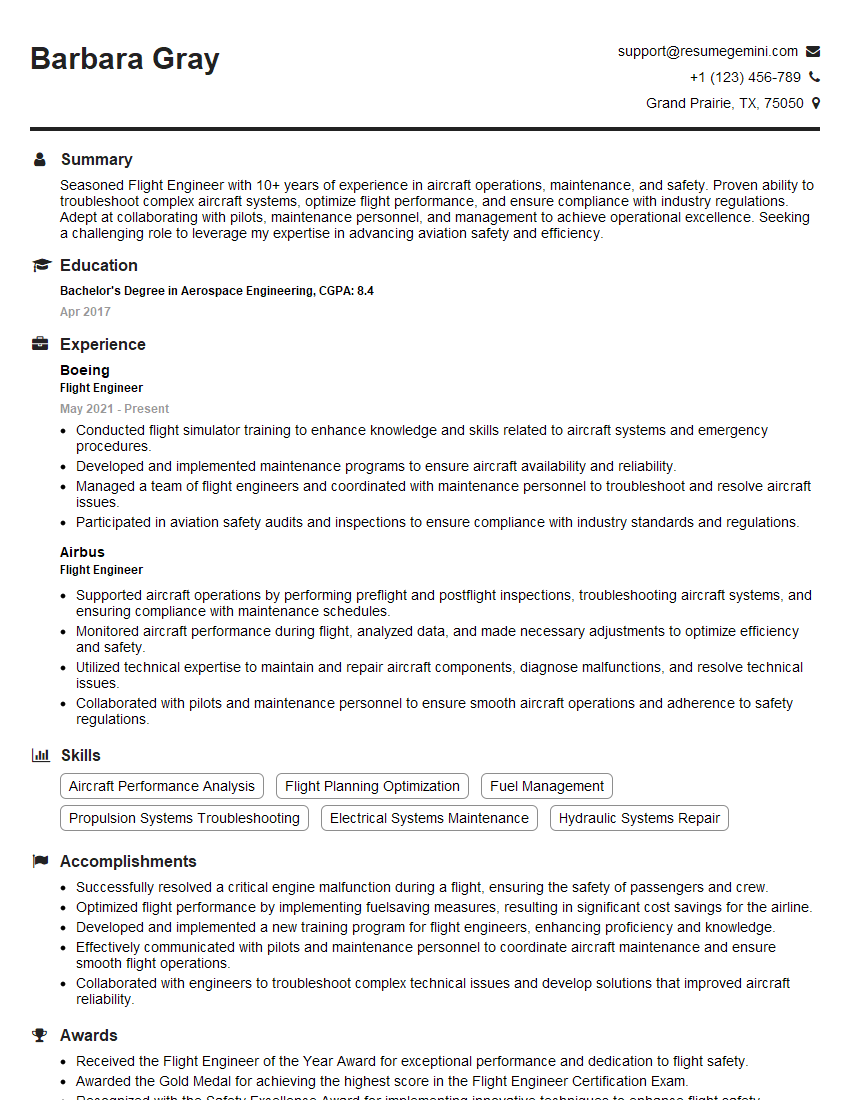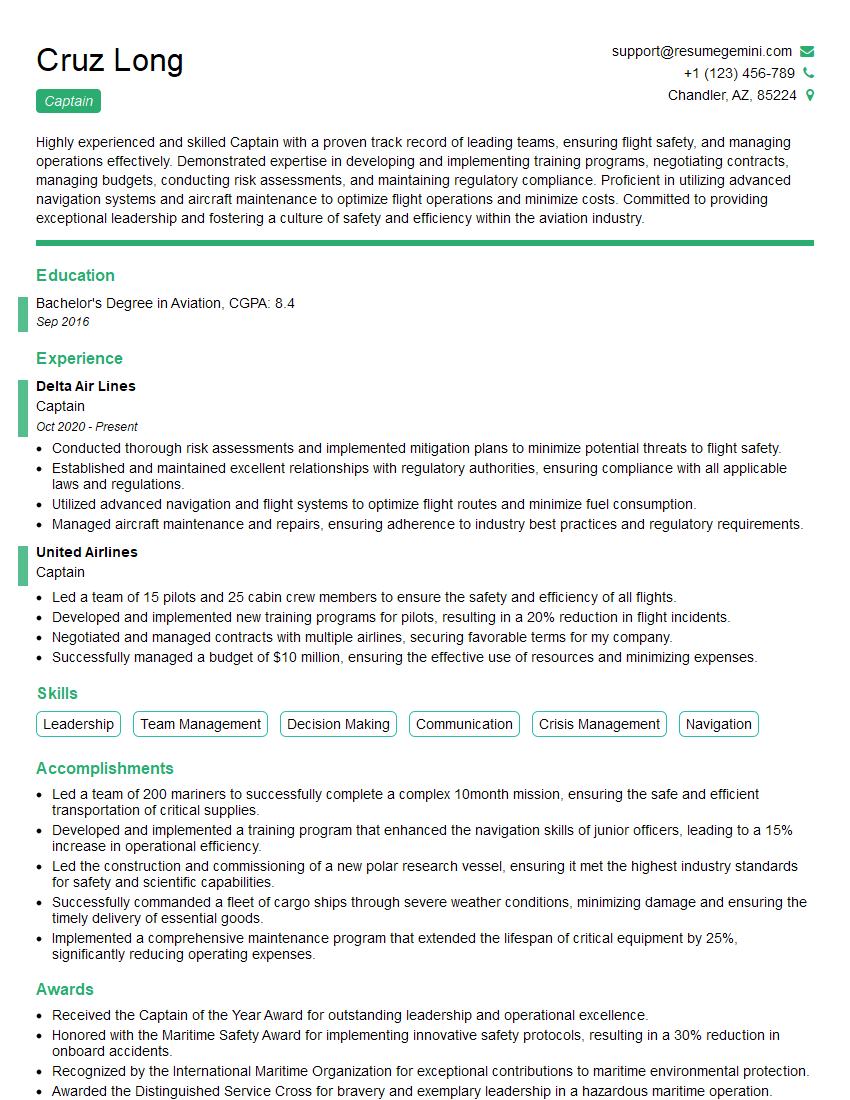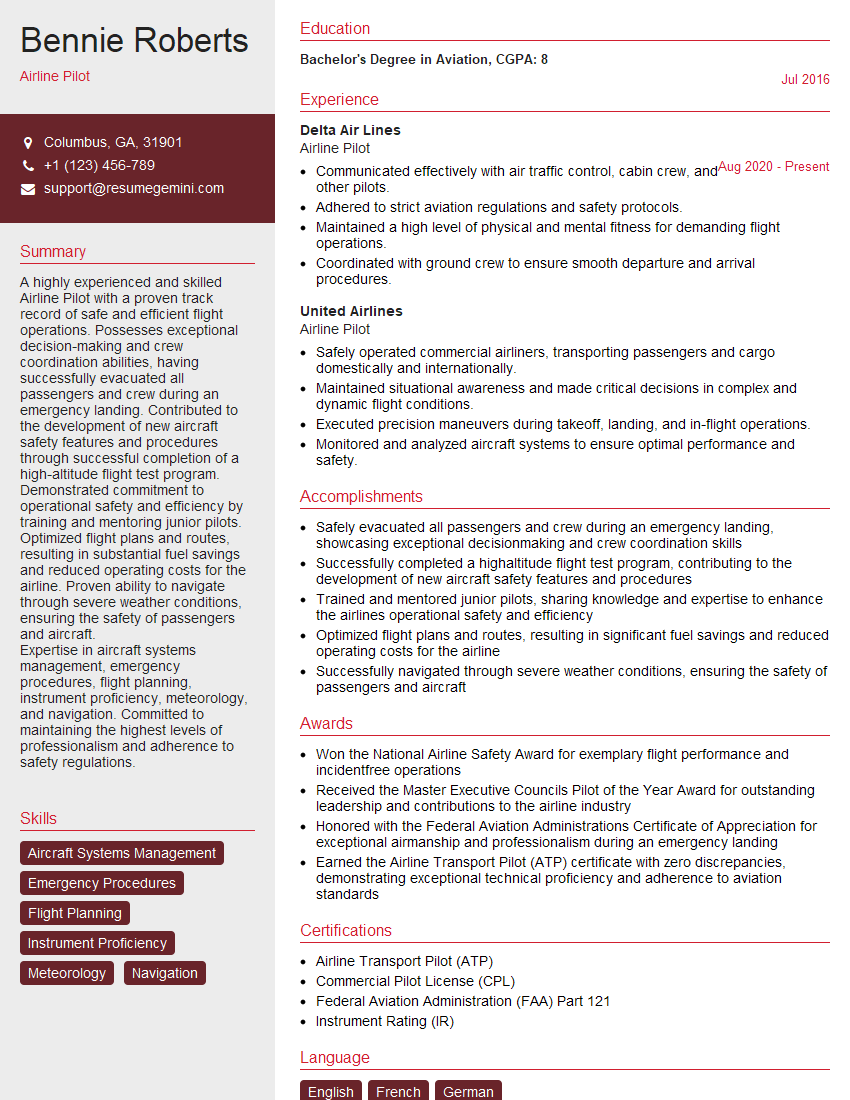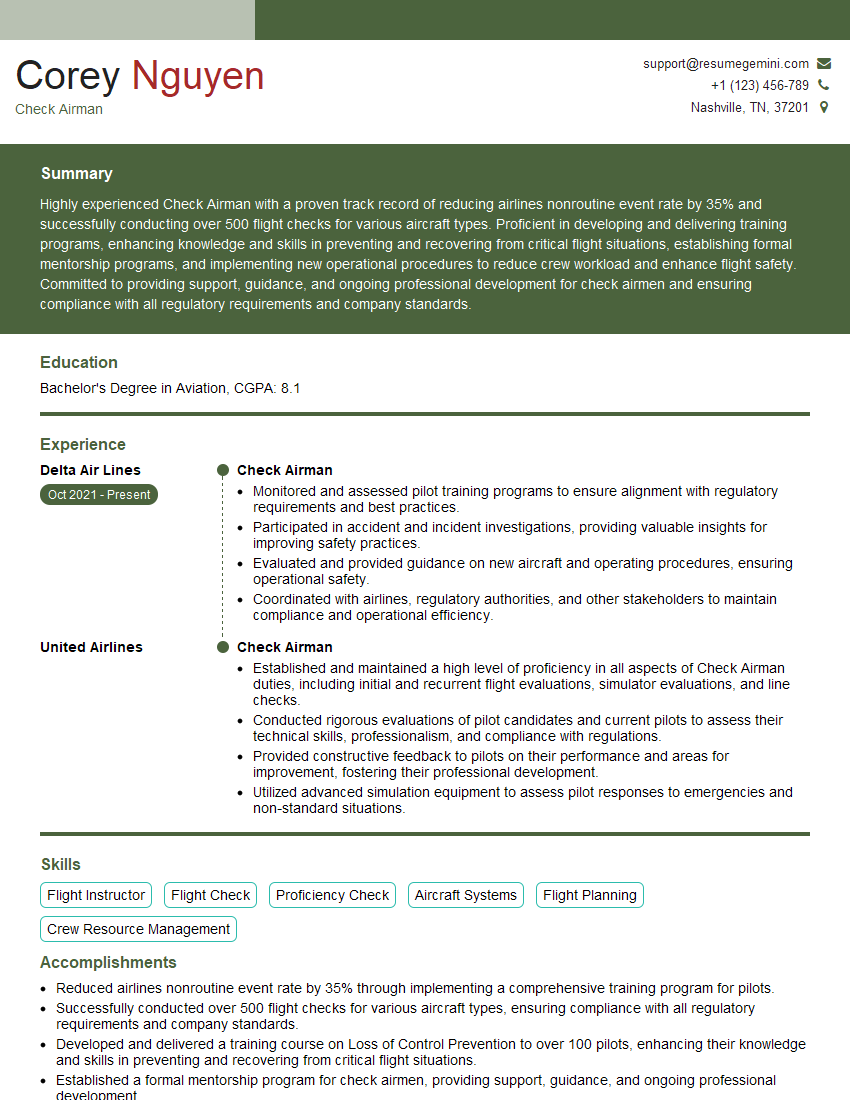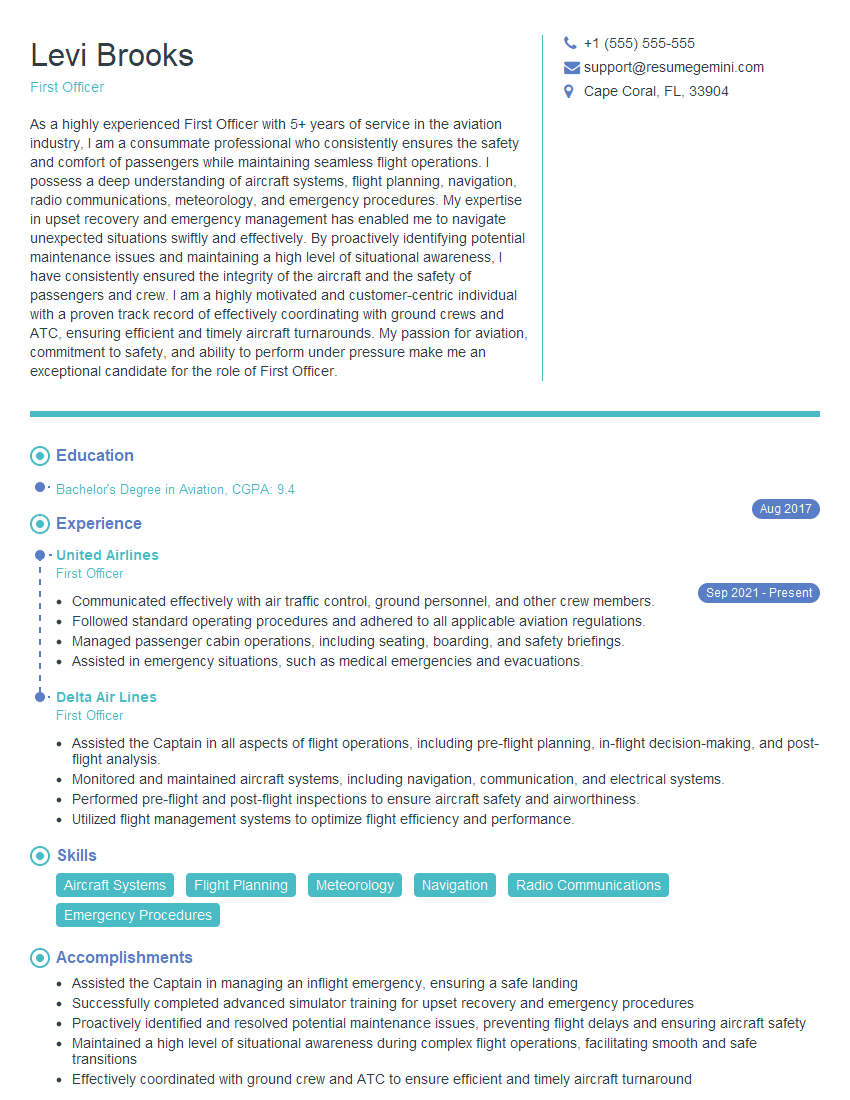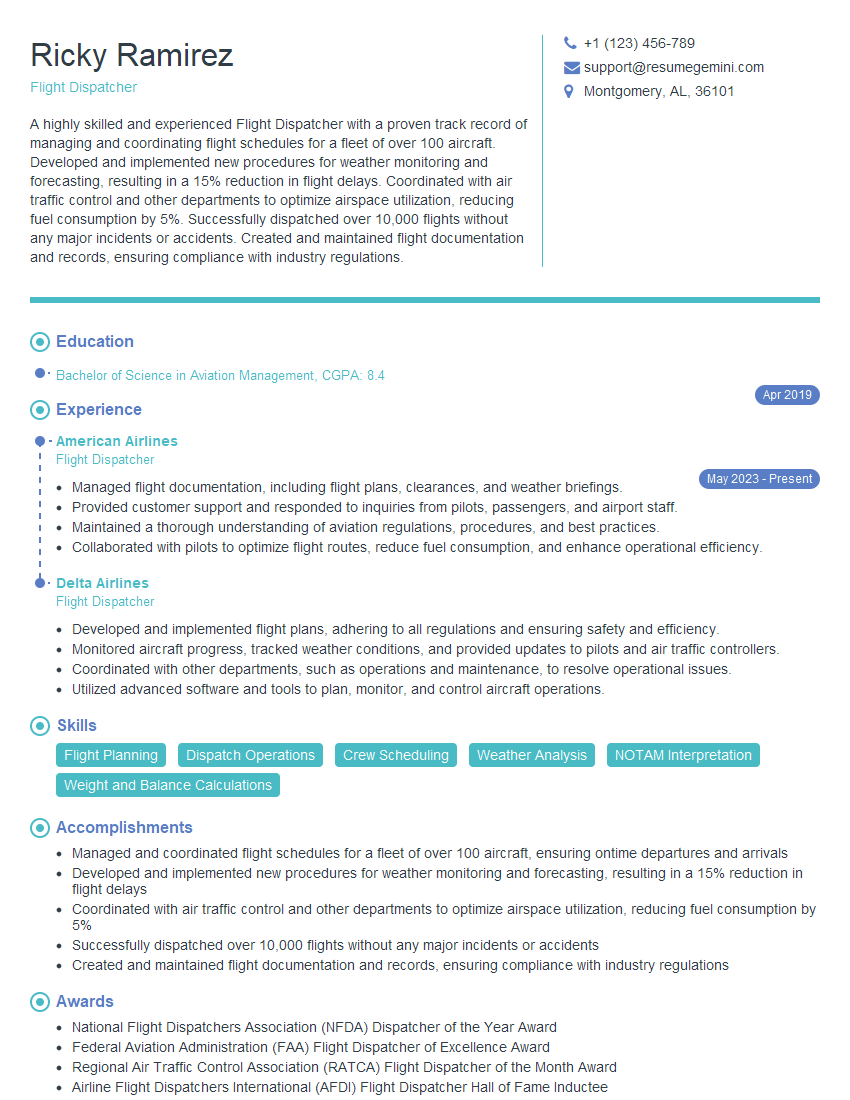Every successful interview starts with knowing what to expect. In this blog, we’ll take you through the top Cockpit Management and Crew Coordination interview questions, breaking them down with expert tips to help you deliver impactful answers. Step into your next interview fully prepared and ready to succeed.
Questions Asked in Cockpit Management and Crew Coordination Interview
Q 1. Describe your experience managing cockpit resources during abnormal situations.
Managing cockpit resources during abnormal situations hinges on a calm, decisive approach rooted in training and established procedures. It’s about prioritizing tasks, leveraging the crew’s expertise, and maintaining clear communication. My experience includes numerous scenarios, from unexpected engine failures to severe weather encounters. In each case, the initial focus is on immediate safety: addressing the immediate threat (e.g., engine shutdown, initiating emergency descent). This involves a rapid assessment of the situation, utilizing available systems and checklists, and then delegating tasks effectively to the crew based on their skills and experience. For example, during a sudden decompression, my priority would be to immediately don oxygen masks, assess the situation, and then begin the emergency descent procedure, delegating tasks like contacting ATC and preparing for an emergency landing to the First Officer. Constant reassessment is crucial; the initial priorities may change based on evolving circumstances. Post-event, a thorough debriefing – focusing on what went well and what could be improved – is paramount for continuous learning and improvement.
Q 2. Explain your understanding of Crew Resource Management (CRM) principles.
Crew Resource Management (CRM) is a cornerstone of safe and efficient flight operations. It’s more than just teamwork; it’s a systematic approach to leveraging the skills and experience of each crew member to optimize performance and mitigate risk. Key CRM principles include:
- Clear Communication: Using standardized phraseology, active listening, and concise information exchange are vital, especially during high-pressure situations. Think of it like a well-oiled machine—each part plays a critical role, and smooth communication keeps everything working in sync.
- Leadership and Followership: The Captain ultimately holds responsibility, but effective leadership involves delegating tasks appropriately and fostering a collaborative environment. The First Officer and other crew members must be able to offer input and raise concerns without hesitation. A good captain empowers his team.
- Decision Making: Sound judgments must be based on facts, data, and available resources, not on personal biases or emotions. The team should work together to critically assess options and select the optimal course of action, utilizing all resources. This often involves prioritizing based on risks and potential outcomes.
- Situational Awareness: Maintaining a comprehensive understanding of the aircraft’s systems, the surrounding environment, and the flight’s progress is critical, and shared awareness is a powerful tool.
- Error Management: CRM emphasizes proactive error prevention and addressing errors effectively when they occur. This includes establishing a culture of open communication where mistakes can be discussed without fear of retribution, leading to continuous improvement.
CRM is not a set of rigid rules but a flexible framework adaptable to any situation. Its core principle is that working together effectively improves safety and efficiency dramatically.
Q 3. How do you handle conflicting opinions or disagreements within the cockpit crew?
Conflicting opinions in the cockpit are inevitable, and healthy disagreement is even beneficial, leading to a more robust decision-making process. However, these differences must be addressed constructively. My approach involves:
- Active Listening: I make sure everyone feels heard and that their concerns are acknowledged. It’s crucial to understand the reasoning behind different viewpoints.
- Respectful Dialogue: A calm and respectful discussion is essential. I ensure the conversation remains focused on the issue at hand, avoiding personal attacks or emotional outbursts.
- Data-Driven Decisions: The best approach often involves referring to facts, procedures, and available data to help clarify the situation and find a common ground. All options are analyzed based on their safety implications and operational efficiency.
- Consensus Building: The goal is not to win an argument, but to reach a mutually acceptable solution. This may involve compromising or revisiting the decision later if new information becomes available. Ultimately, the safety of the flight comes first, and in a serious disagreement the captain must ultimately make the final decision.
- Post-Flight Debriefing: A calm post-flight discussion can help clarify misunderstandings and prevent future conflicts.
It’s important to remember that the flight deck is a team environment, and effective communication and collaboration are key to success. It’s important for every crew member to feel empowered to express their views, and the captain must make sure that happens, without fear of reprisal.
Q 4. Describe a time you had to make a critical decision under pressure in the cockpit.
During a flight to London, we experienced a sudden and unexpected loss of one engine shortly after takeoff. The initial moments were intense, with alarms sounding and the aircraft experiencing a significant roll. The pressure was immense. My immediate priority was to follow the emergency checklist, which involved maintaining control of the aircraft, initiating a controlled descent, and communicating with ATC. I delegated tasks to the First Officer—contacting ATC, running through the engine failure checklist, and preparing for an emergency landing. The decision to divert to the nearest suitable airport—which was not our original destination—was critical, but a careful calculation of fuel reserves, weather conditions, and runway length informed that choice. The successful emergency landing, albeit a challenging one, resulted from precise execution of procedures, clear communication, and efficient teamwork. The experience highlighted the importance of constant training, meticulous adherence to procedures, and the effectiveness of CRM principles under extreme pressure.
Q 5. How do you prioritize tasks and manage workload effectively during a complex flight?
Prioritizing tasks and managing workload effectively during a complex flight requires a systematic approach. I utilize a combination of techniques:
- Pre-Flight Planning: Thorough pre-flight preparation is paramount. This includes careful review of the flight plan, weather conditions, NOTAMs (Notices to Airmen), and any potential challenges. This reduces unexpected workload during the flight.
- Task Prioritization: I use a matrix that considers the urgency and importance of each task, addressing the most critical items first. For example, during an approach, navigation and managing altitude and speed take precedence over less critical tasks.
- Delegation: I effectively delegate tasks based on crew member expertise and available resources. This optimizes workflow and ensures that nothing falls through the cracks.
- Workload Sharing: It’s crucial for all crew members to be aware of each other’s workload and to assist where possible. Open communication about workload is vital.
- Automation: I leverage aircraft automation to reduce the manual workload, but always maintain close supervision of automated systems.
- Checklists: Using checklists helps ensure that no steps are missed during critical phases of the flight, from pre-flight to landing.
This combination of planning, prioritization, delegation, and workload sharing helps maintain a controlled and efficient flight operation, even during complexity.
Q 6. Explain your process for conducting pre-flight briefings and checklists.
Pre-flight briefings and checklists are non-negotiable for safe and efficient flights. My process involves:
- Pre-Flight Briefing: This session covers the flight plan, weather conditions, NOTAMs, anticipated challenges, and contingency plans. Each crew member contributes their insights and understanding. It ensures we’re all on the same page before we even start the engines.
- Checklist Use: I utilize both normal and abnormal checklists meticulously. These are not merely a formality; they are a vital safety net, ensuring that critical procedures are followed consistently, reducing errors, and enhancing safety. The checklists are used in a methodical way, both verbally and visually confirming actions.
- Documentation Review: Relevant documentation, including the flight plan, weather reports, and aircraft performance data, are reviewed to confirm their accuracy.
- Communication Confirmation: Clear communication is crucial to confirm that all crew members understand their roles, responsibilities, and the flight plan. This confirmation happens through active listening and mutual questioning.
- Contingency Planning: Discussing and planning for potential problems or unexpected events—like diversions, mechanical issues, or medical emergencies—is crucial.
The pre-flight briefing and checklist process is a team effort. Open communication and collaboration are crucial to ensure a safe and successful flight.
Q 7. How do you ensure effective communication with air traffic control?
Effective communication with air traffic control (ATC) is paramount for safety and efficiency. My approach centers on:
- Clear and Concise Language: I use precise and standardized phraseology, avoiding ambiguity. This minimizes the potential for misunderstandings, especially during critical phases of the flight like approaches and departures.
- Active Listening: I pay close attention to ATC instructions and acknowledge them clearly. Repeating back instructions ensures clarity and reduces the possibility of errors.
- Professionalism: Maintaining a professional and respectful demeanor is essential. This contributes to positive working relationships with ATC personnel.
- Proactive Communication: I proactively inform ATC of any significant changes in the flight plan, unusual circumstances, or potential problems. Early notification gives ATC ample time to react and make necessary adjustments.
- Emergency Procedures: In emergency situations, I follow established procedures to communicate the nature of the emergency effectively, and concisely. Clear communication is critical during emergency situations.
Open and clear communication with ATC is a cornerstone of a safe and efficient flight operation, and is paramount in times of emergency. Mutual respect and adherence to procedures ensure a smooth interaction.
Q 8. Describe your experience with handling emergencies and deviations from the flight plan.
Emergency and deviation handling is paramount to safe flight operations. My experience encompasses a range of scenarios, from minor technical issues to more serious events requiring immediate and decisive action. For example, during a flight from London to New York, we experienced unexpected turbulence causing a temporary loss of communication with air traffic control. My immediate actions included: switching to emergency frequencies, initiating a descent to a safer altitude to minimize the impact of turbulence, and briefing the crew and passengers calmly and clearly on the situation. We successfully navigated the turbulence, re-established communication, and completed the flight safely, following emergency procedures meticulously and adhering to CRM (Cockpit Resource Management) principles.
In the case of deviations from the flight plan, such as unexpected weather diversions, I utilize my knowledge of weather patterns, alternate airports, and fuel management to determine the safest and most efficient course of action. Effective communication with air traffic control is crucial, and I make sure to provide regular updates on our progress and any changes to our expected time of arrival. Each deviation is thoroughly documented and analyzed post-flight to identify potential areas for improvement in our planning and decision-making processes.
- CRM (Cockpit Resource Management): A teamwork-based approach to flight operations focusing on effective communication, shared decision-making, and error management.
- Risk Assessment: A structured evaluation of potential hazards and the development of mitigation strategies.
- Emergency Procedures: Detailed, step-by-step guidelines for handling various emergencies.
Q 9. How do you maintain situational awareness in the cockpit?
Maintaining situational awareness (SA) in the cockpit is a continuous process requiring constant vigilance and effective communication. It’s like being the conductor of an orchestra, keeping track of every instrument (system) and making sure they all work together harmoniously. This involves monitoring numerous aspects of the flight simultaneously, including:
- Flight Instruments: Constantly scanning airspeed, altitude, heading, vertical speed, and other critical parameters.
- Navigation Systems: Verifying our position against multiple sources (GPS, VOR, etc.) and ensuring we are on the planned route.
- Weather Radar & Reports: Monitoring weather conditions both ahead and along our flight path, anticipating potential hazards.
- Communication: Maintaining clear communication with Air Traffic Control (ATC) and the flight crew.
- Aircraft Systems: Monitoring the performance of all aircraft systems, looking for any anomalies.
- Human Factors: Considering the workload and alertness levels of the crew.
Cross-checking information from different sources is vital for accurate SA. For instance, if the GPS shows a discrepancy from the other navigation systems, a deeper investigation is required. Effective communication within the crew ensures everyone has the same understanding of the situation, contributing to a shared SA. Regular briefing and debriefing sessions further enhance this process.
Q 10. What are your strategies for preventing and managing pilot fatigue?
Pilot fatigue is a significant safety concern. My strategies for prevention and management focus on proactive measures and personal responsibility. It’s like ensuring a car gets regular maintenance; preventing problems is better than fixing them.
- Restful Sleep: Prioritizing adequate sleep before and after flights, following a consistent sleep schedule whenever possible.
- Healthy Diet & Hydration: Maintaining a balanced diet and staying properly hydrated throughout the day.
- Regular Exercise: Engaging in physical activity to improve physical and mental well-being.
- Stress Management: Implementing relaxation techniques like meditation or mindfulness to manage stress levels.
- Crew Resource Management (CRM): Leveraging crew collaboration to share the workload and prevent fatigue buildup. If one pilot feels fatigued, the other can take over certain tasks.
- Duty Time Limitations: Strictly adhering to the regulations and company policies regarding flight duty time limitations.
- Fatigue Recognition: Being aware of the signs and symptoms of fatigue in myself and my fellow crew members. This includes things like slow reaction times or difficulty concentrating. If I or another crew member demonstrate signs of fatigue, we will take appropriate rest periods.
Reporting fatigue is crucial. If I feel fatigued, I’ll report it to the relevant authorities and request appropriate rest.
Q 11. Explain your understanding of human factors and their influence on flight safety.
Human factors encompass the physical and cognitive characteristics of individuals and how they interact with their environment. They significantly influence flight safety. Think of it as the human element interacting with the technical system. A simple error can cause serious problems.
- Workload Management: Effective workload distribution amongst the crew helps prevent errors. For example, during busy phases of flight, we divide tasks efficiently, ensuring neither pilot is overloaded.
- Stress and Fatigue: As discussed earlier, managing stress and fatigue is crucial to maintain performance and avoid errors.
- Communication: Clear and concise communication is paramount for effective teamwork and problem-solving. Using standard phraseology ensures consistent understanding.
- Decision-Making: Utilizing a systematic approach to decision-making, considering all available information and potential risks.
- Situational Awareness: Maintaining continuous situational awareness (SA) is critical to anticipate and respond to developing situations.
Understanding human factors helps identify potential risks and implement strategies to minimize them. For instance, we utilize checklists to ensure critical procedures are followed consistently, mitigating the chance of human error.
Q 12. How do you incorporate automation effectively into your flight operations?
Automation plays a vital role in modern flight operations, enhancing safety and efficiency. However, it is crucial to use it effectively and understand its limitations. It’s like having a sophisticated tool; you need to know how to use it correctly.
- Understanding Limitations: Automation is a tool, not a replacement for pilot judgment. I always maintain a thorough understanding of the system’s capabilities and limitations.
- System Monitoring: I closely monitor all automated systems for proper functionality and unexpected behavior. Cross-checking data from different sources is vital.
- Situational Awareness: Automation does not replace situational awareness; I remain vigilant and prepared to take over manual control if needed.
- Proper Training: Extensive training is needed to use automation effectively and safely. Regular recurrent training keeps me updated on system changes and best practices.
- Manual Back-up: I am proficient in operating the aircraft manually, ready to take over in case of automation failures.
For example, while using autopilot, I regularly monitor its performance and parameters, always being ready to disengage and take manual control should the need arise. This ensures a safety margin.
Q 13. Describe your experience with using cockpit displays and flight management systems.
My experience with cockpit displays and Flight Management Systems (FMS) is extensive. Modern cockpits are sophisticated, and proficiency is key. I regularly use various display systems, like PFD (Primary Flight Display) and MFD (Multi-Function Display), for navigation, system monitoring, and communication. I also use a wide range of functionalities provided by the FMS.
- Navigation: Utilizing the FMS for route planning, navigation, and performance calculations, including fuel planning.
- System Monitoring: Using the displays to monitor aircraft systems, engines, and other critical parameters.
- Communication: Interfacing with ATC systems via various display screens.
- Weather Monitoring: Interpreting weather radar and accessing weather information on the displays.
- Performance Calculations: Using the FMS to calculate take-off and landing performance, fuel consumption, and other flight parameters.
I’m also well-versed in managing any potential display discrepancies or system malfunction, and I have strong troubleshooting skills to quickly resolve any issues. Proficiency with these systems is essential for safe and efficient operations.
Q 14. How do you ensure compliance with regulatory requirements and company procedures?
Compliance with regulations and company procedures is non-negotiable. It’s the foundation of safe flight operations. My approach is proactive and multi-faceted.
- Regular Review: I regularly review all relevant regulations and company standard operating procedures (SOPs).
- Training: I participate in recurrent training programs that keep me updated on regulatory changes and company policies.
- Documentation: I maintain meticulous flight documentation, ensuring compliance with all reporting requirements.
- Self-Auditing: I perform self-audits of my flight operations, looking for any potential deviations from procedures.
- Proactive Reporting: I promptly report any safety concerns or non-compliance issues.
- Understanding the impact of non-compliance: I fully understand the serious consequences of non-compliance, from fines and sanctions to potential accidents and loss of life. This understanding drives my commitment to adherence to regulations.
For example, I regularly check for any Airworthiness Directives (ADs) applicable to the aircraft type, ensuring all necessary maintenance and inspections are completed according to the regulations. This commitment to compliance ensures that every flight is carried out to the highest safety standards.
Q 15. Describe a time you had to adapt your approach due to unexpected weather conditions.
Adapting to unexpected weather is crucial for safe flight operations. It requires a swift and methodical shift in our pre-flight plans, often involving rerouting, altering altitudes, or adjusting speeds. For instance, during a flight from London to New York, we encountered unexpected turbulence and strong headwinds over the Atlantic. Our initial flight plan projected a smooth arrival. However, real-time weather radar showed a significant weather system developing ahead of our projected path.
My immediate response involved consulting with the First Officer and reviewing available data from Air Traffic Control (ATC) and onboard weather systems. We collaboratively assessed the risk posed by the storm and considered alternative routes. After comparing several options, we chose a slightly longer, but safer route that avoided the most severe weather. This involved recalculating fuel consumption and flight time, communicating the change to ATC, and informing the cabin crew about the anticipated delay. Successfully navigating the situation required close collaboration, quick decision-making, and a calm, professional demeanor to reassure both the crew and passengers.
Career Expert Tips:
- Ace those interviews! Prepare effectively by reviewing the Top 50 Most Common Interview Questions on ResumeGemini.
- Navigate your job search with confidence! Explore a wide range of Career Tips on ResumeGemini. Learn about common challenges and recommendations to overcome them.
- Craft the perfect resume! Master the Art of Resume Writing with ResumeGemini’s guide. Showcase your unique qualifications and achievements effectively.
- Don’t miss out on holiday savings! Build your dream resume with ResumeGemini’s ATS optimized templates.
Q 16. How do you effectively delegate tasks and responsibilities within the cockpit crew?
Effective delegation in the cockpit hinges on clear communication, defined roles, and mutual respect. We operate under a strict hierarchical structure where the Captain holds ultimate authority, but efficient task management relies on shared responsibility. Before takeoff, we have a thorough briefing where I clearly assign roles and responsibilities. This might involve designating the First Officer as the primary pilot monitoring navigation while I focus on aircraft systems. During the flight, we dynamically adjust responsibilities based on workload and changing circumstances. For example, if we encounter an unexpected mechanical issue, I might delegate the task of troubleshooting specific systems to the First Officer while I focus on maintaining safe flight parameters and communicating with ATC. The key is to provide sufficient autonomy while maintaining oversight to ensure task completion and safety. We regularly check in, ensuring smooth information flow and immediate resolution of any arising issues.
Q 17. Explain your understanding of sterile cockpit procedures.
Sterile cockpit procedures are crucial for enhancing safety by minimizing distractions during critical phases of flight, such as takeoff and landing, and any other times specified by the airline’s SOPs. During these critical phases, all non-essential conversations and activities are suspended. This means no casual chats, no unnecessary radio calls, and no distractions like reviewing non-essential documents. The focus is entirely on flying the aircraft. Think of it like a surgeon performing a delicate operation – complete concentration is paramount. Any deviation from the established procedures requires a conscious decision and justification. This is not about stifling communication, but rather about optimizing focus at times when the margin for error is significantly reduced. This helps prevent errors caused by distraction and promotes a more controlled, safer environment.
Q 18. How do you identify and mitigate potential risks during flight operations?
Risk mitigation in flight operations is a continuous process, starting well before takeoff. It involves a layered approach, beginning with pre-flight planning where we meticulously review weather forecasts, NOTAMs (Notices to Airmen), and aircraft technical logs. During flight, we constantly monitor various factors, including weather, air traffic density, aircraft performance, and crew fatigue. We use a structured risk assessment process. For example, if we anticipate encountering severe turbulence, we’ll adjust our altitude or route to minimize exposure. If a technical issue arises, we follow established troubleshooting procedures and may even divert to a suitable airport if necessary.
Regular communication with ATC, and proactive monitoring and reporting, allow early detection of potential risks. We constantly consider the consequences of our decisions, weighing the risks against the benefits and ensuring the safety of passengers and crew always takes priority. Think of it as a chess game – anticipating potential threats and proactively planning our response.
Q 19. Describe your experience with troubleshooting technical issues in the cockpit.
Troubleshooting technical issues in the cockpit requires a systematic approach and a thorough understanding of the aircraft systems. During a flight, we experienced a malfunction in one of the aircraft’s navigation systems. My initial response was to remain calm and follow established procedures. This involved switching to a backup system, running through pre-defined checklists to diagnose the problem, and verifying system performance. This systematic approach helped us to quickly assess the nature and severity of the issue. Next, we communicated the issue to ATC, and sought further assistance from maintenance personnel on the ground who provided further guidance. They provided step-by-step instructions using diagnostic tools, and we carefully followed these steps while monitoring the aircraft’s other vital systems. The issue was eventually resolved, and we were able to continue our flight safely.
Q 20. How do you handle communication breakdowns within the cockpit crew?
Communication breakdowns are rare, but addressing them quickly and effectively is crucial. The cornerstone of preventing breakdowns is clear, concise, and unambiguous communication from the start. If a misunderstanding does arise, I prioritize open communication and active listening. This includes seeking clarification and ensuring everyone understands the situation fully. We use standard phraseology (e.g., aviation-specific terminology) to minimize ambiguity. If the issue persists, we may employ a structured problem-solving approach – defining the problem, identifying possible causes, proposing solutions, and selecting the best course of action. The goal is not to place blame, but to identify and address the root cause of the breakdown and implement measures to prevent recurrence. A well-functioning crew relies on mutual respect, and a commitment to address any communication issues constructively.
Q 21. How do you provide constructive feedback to your crew members?
Providing constructive feedback is about improving performance and fostering a safer working environment. I ensure feedback is specific, timely, and focuses on behavior rather than personality. For example, instead of saying ‘You were careless,’ I might say, ‘During the approach, the checklist item regarding flap settings was overlooked. Let’s review the procedure together.’ I use the ‘sandwich method’ – starting with positive feedback, highlighting the area needing improvement, and ending with more positive reinforcement and encouragement. The goal is to help them learn and grow, and to contribute to our shared goal of safe and efficient flight operations. I always invite questions and ensure a two-way conversation, allowing the crew member to share their perspective. Regular feedback sessions and debriefings are also important to maintain open communication channels.
Q 22. Explain your approach to managing workload during instrument approaches.
Managing workload during instrument approaches is crucial for safety. My approach centers around proactive planning and efficient task management. Before even starting the approach, I’ll ensure I have a clear understanding of the approach plate, weather conditions, and any potential challenges. This includes verifying the approach frequency, checking for any NOTAMs (Notice to Airmen) affecting the airport, and confirming our aircraft’s performance capabilities.
During the approach itself, I utilize a structured, prioritized approach. Critical tasks, like monitoring airspeed, altitude, and heading, are given priority. Secondary tasks, like communicating with air traffic control or adjusting the autopilot, are integrated efficiently without compromising primary tasks. I use checklists meticulously, ensuring each step is completed correctly and in the right order. This prevents missed steps and keeps a structured workflow, especially under pressure. Think of it like a chef following a recipe – each step is important for a perfect outcome. If any unexpected situation arises, we immediately address it as a team, utilizing CRM (Crew Resource Management) principles. For example, if a sudden change in weather requires an immediate adjustment, we clearly communicate the change, reassess the situation and adjust our actions accordingly.
Q 23. How do you handle distractions and interruptions in the cockpit?
Distractions and interruptions are inevitable in the cockpit, but effective management is paramount. We use a combination of techniques to minimize their impact. Firstly, we proactively identify potential distractions – such as noisy cabin announcements or unexpected radio calls – and discuss strategies to mitigate them before the flight. This is part of our pre-flight briefing. During the flight, we use clear communication to manage interruptions. For example, one pilot will handle radio communications while the other focuses on flying the aircraft. If a distraction occurs, the pilot dealing with the distraction will verbally inform the other pilot, preventing any misunderstandings. We employ a ‘sterile cockpit’ rule during critical phases of flight (e.g., takeoff, landing, and approach), limiting non-essential conversations and activities. Imagine a surgeon performing a complex procedure – interruptions must be kept to a minimum. Additionally, we use CRM to deal with distractions, with open communication and clear delegation of tasks to ensure safety. We are trained to immediately address and categorize any unexpected situation, making sure that important actions are never overlooked.
Q 24. Describe your experience with monitoring and managing fuel consumption.
Fuel management is a critical aspect of flight operations, involving planning, monitoring, and adjustment. Pre-flight planning uses flight planning software to calculate fuel requirements based on flight distance, weather conditions, weight, and alternate airports. We always add a reserve fuel margin for unforeseen circumstances. During the flight, we continuously monitor fuel consumption, comparing it to the planned figures. This involves regularly checking the fuel gauges, calculating fuel burn rate, and adjusting flight parameters if necessary. We also use the aircraft’s performance data to forecast our remaining fuel at different points during the flight, especially when considering diversions. If we anticipate a potential fuel shortage, we immediately inform Air Traffic Control (ATC) and plan for a suitable diversion airport. In one instance, during a flight across the Atlantic, we encountered unexpectedly strong headwinds, significantly increasing fuel consumption. We immediately adjusted our flight plan, opting for a more fuel-efficient cruise altitude and speed, regularly updating ATC on our fuel status. We successfully landed with adequate reserves, highlighting the importance of continuous monitoring and proactive decision making.
Q 25. How do you ensure compliance with weight and balance limitations?
Weight and balance calculations are crucial for aircraft safety and performance. Before each flight, we meticulously calculate the aircraft’s center of gravity (CG) to ensure it falls within the approved limits specified in the aircraft’s flight manual. This involves precisely weighing the aircraft and all its components (fuel, baggage, cargo, passengers). The weight and balance calculation is often performed using dedicated software or calculation sheets. We verify the calculation, ensuring the aircraft is within the weight and balance limits stated in the relevant documents before commencing the flight. Exceeding these limits can affect the aircraft’s stability and controllability, potentially leading to dangerous flight characteristics. Imagine a seesaw – if the weight isn’t distributed correctly, the seesaw won’t balance. Similarly, an improperly balanced aircraft can experience handling difficulties.
Q 26. Describe your understanding of different types of communication failures.
Communication failures can significantly impact flight safety and efficiency. These failures can range from simple misunderstandings to complete loss of communication. Some common types include:
- Radio failures: Complete loss of radio contact with ATC or other aircraft.
- Transmission errors: Misunderstandings due to unclear or garbled messages, possibly due to static or interference.
- Reception errors: Failure to receive messages due to radio malfunctions or environmental factors.
- Language barriers: Difficulty understanding messages due to language differences.
Q 27. How do you use checklists to ensure safety and efficiency during flight operations?
Checklists are integral to safe and efficient flight operations. They provide a standardized and structured approach to completing critical procedures, reducing the risk of human error. We use checklists for every phase of flight, from pre-flight checks to post-flight shutdowns. They are not just a list of tasks but tools to ensure each step is conducted thoroughly. Each checklist item is treated as a safety-critical step. They’re designed to prompt a systematic verification of critical systems. Before takeoff, we conduct a comprehensive pre-flight checklist, verifying everything from fuel levels and engine performance to communication systems and navigation equipment. During the flight, specific checklists guide us during critical phases, such as approach, landing, and emergency procedures. The methodical approach also enhances teamwork and efficiency. We use a callout system, which involves one pilot calling out each item on the checklist, while the other pilot confirms its completion. This reduces the chance of omissions and fosters collaboration. Checklists help to ensure a standardized and consistent approach, improving safety and efficiency across diverse operational conditions.
Q 28. Explain your understanding of the importance of maintaining a positive and supportive cockpit environment.
Maintaining a positive and supportive cockpit environment is essential for safe and efficient flight operations. A positive environment fosters effective teamwork, clear communication, and a shared sense of responsibility. This is the core of CRM (Crew Resource Management). A supportive atmosphere encourages open communication, allowing pilots to express concerns or suggestions without fear of reprisal. It is crucial for timely identification and resolution of problems. In a tense or negative environment, errors are more likely to occur. We’re trained to manage differences constructively. Each crew member is accountable for his/her actions, but collaboration ensures collective focus on safe flight operations. We actively practice active listening, ensuring we understand each other’s perspectives. We celebrate success, and openly discuss areas for improvement. This fosters trust and mutual respect, ultimately making the flight safer and more efficient. This supportive environment allows us to address challenges effectively without jeopardizing teamwork or safety, which is paramount in high-pressure situations.
Key Topics to Learn for Cockpit Management and Crew Coordination Interview
- CRM (Crew Resource Management): Understanding the principles of CRM, including communication, teamwork, leadership, and decision-making within the cockpit environment. Consider practical examples of how effective CRM can prevent incidents.
- Situational Awareness: Developing and maintaining a comprehensive understanding of the flight’s status, surrounding environment, and potential hazards. Explore how to effectively manage workload and prioritize tasks to maintain optimal situational awareness.
- Flight Planning and Navigation: Demonstrate knowledge of flight planning procedures, navigation techniques, and the use of various navigation systems. Be prepared to discuss problem-solving scenarios involving deviations from the flight plan.
- Emergency Procedures and Response: Thorough understanding of emergency procedures, including handling malfunctions, communication with air traffic control, and executing emergency checklists. Practice describing your approach to handling various emergency situations.
- Risk Management: Discuss your understanding of risk assessment and mitigation strategies within the context of flight operations. Be ready to illustrate how you identify and address potential risks proactively.
- Human Factors: Explore the impact of human factors on flight safety, such as fatigue, stress, and workload management. Be prepared to discuss strategies for mitigating these factors and promoting crew well-being.
- Communication and Coordination: Showcase your proficiency in clear, concise, and effective communication with the flight crew, air traffic control, and other stakeholders. Discuss techniques for managing communication during critical phases of flight.
Next Steps
Mastering Cockpit Management and Crew Coordination is paramount for career advancement in aviation, leading to increased responsibility and higher earning potential. A strong resume is crucial for showcasing your skills and experience to prospective employers. Crafting an ATS-friendly resume is essential to navigate applicant tracking systems and ensure your application is seen. To create a compelling and effective resume that highlights your expertise in Cockpit Management and Crew Coordination, we recommend using ResumeGemini. ResumeGemini provides tools and resources to build a professional resume, and examples of resumes tailored specifically to Cockpit Management and Crew Coordination are available to help guide you.
Explore more articles
Users Rating of Our Blogs
Share Your Experience
We value your feedback! Please rate our content and share your thoughts (optional).
What Readers Say About Our Blog
Hello,
We found issues with your domain’s email setup that may be sending your messages to spam or blocking them completely. InboxShield Mini shows you how to fix it in minutes — no tech skills required.
Scan your domain now for details: https://inboxshield-mini.com/
— Adam @ InboxShield Mini
Reply STOP to unsubscribe
Hi, are you owner of interviewgemini.com? What if I told you I could help you find extra time in your schedule, reconnect with leads you didn’t even realize you missed, and bring in more “I want to work with you” conversations, without increasing your ad spend or hiring a full-time employee?
All with a flexible, budget-friendly service that could easily pay for itself. Sounds good?
Would it be nice to jump on a quick 10-minute call so I can show you exactly how we make this work?
Best,
Hapei
Marketing Director
Hey, I know you’re the owner of interviewgemini.com. I’ll be quick.
Fundraising for your business is tough and time-consuming. We make it easier by guaranteeing two private investor meetings each month, for six months. No demos, no pitch events – just direct introductions to active investors matched to your startup.
If youR17;re raising, this could help you build real momentum. Want me to send more info?
Hi, I represent an SEO company that specialises in getting you AI citations and higher rankings on Google. I’d like to offer you a 100% free SEO audit for your website. Would you be interested?
Hi, I represent an SEO company that specialises in getting you AI citations and higher rankings on Google. I’d like to offer you a 100% free SEO audit for your website. Would you be interested?
good


